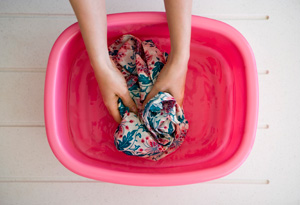Your silk kimono robes and kimono-style robes can definitely keep their elegant sheen, vibrant color, and investment piece-quality with these best-kept secrets on how to care for silk robes:
Hang your silk kimono robe after every use on a hanger and air-dry in a cool and shady place. Be sure to check for sharp edges on the hanger or close to the hanging surface, especially while on travel, so as to avoid touching the robe onto the same, which may cause it to run or rip.
Dry-clean your silk robe using a gentle and biodegradable dry-cleaning agent that is suitable for silk. Ideally, test the strength of your dry-cleaning agent by dotting just a small part of the reverse side or inside of the robe that will not be visible when the robe is worn, should staining might occur.
If you must have to wash your silk robe, use cold water that has been diluted with gentle, biodegradable fabric soap. Rinse several times to remove the soap suds and never wring nor tumble-dry your silk robe in order to remove the excess water. Rather, just let the excess water drip naturally. Again, hang your silk robe on a hanger that has a smooth surface and is not prone to staining and let it dry it on a shady spot to avoid its color from fading.
While not actually necessary, iron your silk robe on its inner side and over low-heat to avoid its color from easily fading. Again, to prevent damage on the visible areas of the robe, test the heat of the iron on a small area of the inside of the robe so that if any damage might occur, such will not be visible from the outside of the robe or when the robe is worn.
When not intending to use your silk robe for a long time, store it in an acid-free environment by placing sheets of acid-free paper in-between the folds and outside the finish-folded silk robe to prevent its fabric from oxidizing, which can cause the yellowing of the fabric or the formation of brown stains. If an acid-free paper is not available, you can also surround your silk robe with silica, which helps to absorb the excess moisture from the environment.
Image: Touch of Europe, Amazon.com
To remove stains from silk robes, remember to avoid scattering the stain to the other areas of the fabric and to exercise proper precaution when attempting to remove the stain, considering that silk is a very delicate fabric, so any mistake can possibly result in a mess.
With fresh liquid stains, blot the stain with tissue paper and dilute lemon or vinegar on a basin of water. Dip the stained area immediately onto the same to remove the stain or use a gentle stain remover. If possible, bring your silk robe immediately to a professional cleaner to avoid incurring further damage to your special clothing.
Article Source: Best-Kept Secrets on How to Care for Silk Robes
Know the popular types of silk fabric that is used to make the finest silk robes from Asia on KimonoRobeStore.com.









